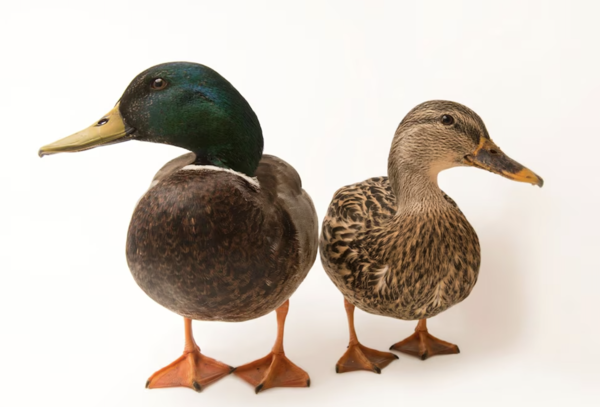Ducks are widely known waterfowl, commonly seen in parks, lakes, and rivers. However, there is a notable distinction between domesticated ducks (often referred to simply as “ducks”) and wild ducks. What is the difference between a duck and a wild duck? In this article, we will explore these differences, delve into the characteristics of wild ducks, and identify the most common species of wild ducks around the world.

The difference between a duck and a wild duck is not just about their habitat or lifestyle, but also their physical traits, behavior, and ecological roles. While domesticated ducks have been bred and kept by humans for thousands of years, wild ducks exist in nature and have adapted to the conditions of the wild.
Domestic Ducks: Domestic ducks are bred in captivity and are commonly found on farms, in zoos, or as pets. These ducks have become accustomed to human environments and are typically dependent on humans for food, shelter, and care. Domestic ducks generally have a calm demeanor and are less wary of humans.
Wild Ducks: Wild ducks, on the other hand, live in natural environments, such as freshwater lakes, rivers, ponds, and marshes. They are highly adapted to survive in the wild and have evolved to be more cautious and alert in their behaviors. Wild ducks can be migratory, often traveling long distances in search of food and breeding grounds.
Size and Appearance: While domestic ducks vary in size depending on the breed, wild ducks tend to be more slender and agile. Wild ducks have more vibrant and varied plumage, which plays a significant role in mating and camouflage in their natural habitats. Domestic ducks, however, have been selectively bred for specific traits like size, egg production, or meat yield, which can result in more uniform appearances across breeds.
Feeding Habits: Domestic ducks are often fed commercial duck feed, which makes them less skilled at foraging for food compared to wild ducks. Wild ducks are omnivores, foraging for seeds, insects, plants, and small fish in their natural habitats. This foraging behavior contributes to their leaner physique and survival in the wild.
When considering wild ducks, it's important to note that there are numerous species found worldwide. However, some wild ducks are more common and widely recognized than others. Below, we list some of the most common wild duck species, providing insights into their characteristics and habitats.
| Wild Duck Species | Scientific Name | Habitat | Distinct Features |
|---|---|---|---|
| Mallard | Anas platyrhynchos | Freshwater lakes, rivers, ponds | The most common wild duck, with a distinctive green head in males. |
| Northern Pintail | Anas acuta | Wetlands, lakes, marshes | Long, pointed tail feathers and slender body. |
| Wood Duck | Aix sponsa | Forested ponds, rivers | Known for vibrant, iridescent plumage and distinctive head patterns. |
| American Black Duck | Anas rubripes | Wetlands, freshwater lakes | Dark plumage, with a brownish body and purple wing patches. |
| Northern Shoveler | Anas clypeata | Shallow wetlands, marshes | Broad, shovel-shaped bill, used to filter food from water. |
| Canvasback | Aythya valisineria | Lakes, ponds, marshes | Known for its distinctive long, sloped bill and red eyes. |
| Feature | Domestic Duck | Wild Duck |
|---|---|---|
| Habitat | Raised in captivity, farms, zoos, or as pets | Natural habitats such as lakes, rivers, ponds, and marshes |
| Feeding Habits | Fed by humans, less skilled at foraging | Skilled foragers, feeding on plants, insects, and small fish |
| Appearance | Selectively bred for size, egg production, or meat | Vivid plumage adapted for mating and camouflage |
| Behavior | Calm, less wary of humans | Cautious, migratory, and alert to predators |
| Size | Varies by breed, often larger than wild ducks | Generally smaller, more slender, and agile |
| Lifespan | Typically shorter, around 5-10 years in captivity | Can live up to 10-15 years in the wild |
| Reproduction | Breed in captivity, controlled by humans | Breed in the wild, often in specific nesting areas |
Wild ducks play an essential role in maintaining the health of ecosystems. Their foraging behavior helps control insect populations and promotes plant growth by dispersing seeds. Additionally, their migration patterns contribute to the balance of various environments as they interact with different habitats across seasons. By studying wild ducks, scientists can also monitor environmental changes, as these species are often indicators of the overall health of wetland ecosystems.
In conclusion, while both domestic ducks and wild ducks belong to the same family of waterfowl, they differ significantly in their habitat, behavior, appearance, and ecological roles. Understanding these differences is crucial for conservation efforts, especially as some wild duck species face threats from habitat loss and climate change. Whether you're a bird enthusiast or simply curious about the world of ducks, recognizing the diverse species and their unique characteristics adds to our appreciation of these fascinating creatures.
animal tags: Anatidae
We created this article in conjunction with AI technology, then made sure it was fact-checked and edited by a Animals Top editor.